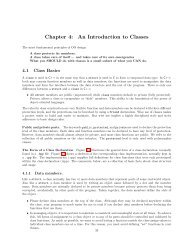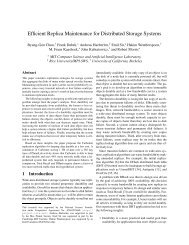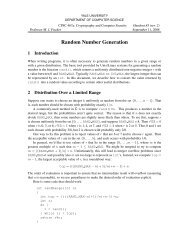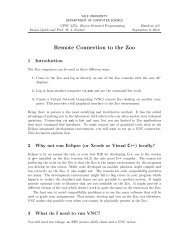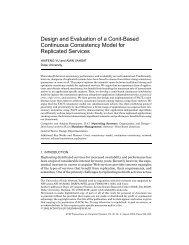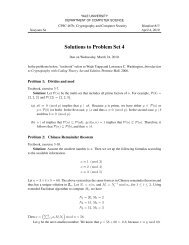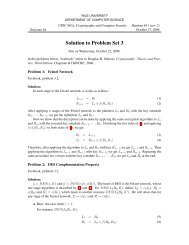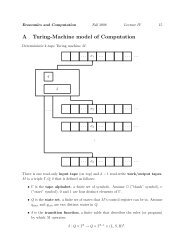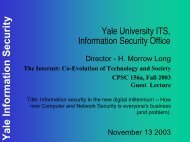Unreliable Failure Detectors for Reliable Distributed Systems
Unreliable Failure Detectors for Reliable Distributed Systems
Unreliable Failure Detectors for Reliable Distributed Systems
Create successful ePaper yourself
Turn your PDF publications into a flip-book with our unique Google optimized e-Paper software.
264 T. D. CHANDRA AND S. TOUEGFO at the beginning of the run, that is, Vt G 9: FO(t ) = II ~ U llcr.~h=d.ProcessqO G 110 permanently suspects every process in ITl U l_IC~h,d, that is, Vt C 9:HO(qO, t) = II ~ U llcr.~h,d = FO(t). No other process suspects any process,that is, Vt E 9, Vq # qO: HO(q, t) = 0. Clearly, !3 satisfies the specification ofa Strongly m-Mistaken failure detector in Ro.Run RI = (Fl, Z-ll, ]1, Sl, Tl). All processes propose 1. All processes in 111are correct in F1, while all the ~ processes in II. U IIcr.,~,d crash in F1 at thebeginning of the run, that is, Vt ~ 9: Fl(t) = II. U IIc,.,hcd. Process q, E II ~permanently suspects every process in II. U Ilc,a$k,d, and no other processsuspects any process. Q satisfies the specification of a Strongly m-Mistakenfailure detector in R ~.If R. or R ~violates the specification of Consensus, A does not solve Consensususing $3, as we wanted to show. Now assume that both R. and R ~ satisfy thespecification of Consensus. In this case, all correct processes decide O in R. and1 in R1. Let tobe the time at which go decides O in Ro, and let tlbe the time atwhich q ~ decides 1 in R ~. We now describe the behaviour of $3 and a run R~ =(F~, HA, IA, S~, T~) of A using Q that violates the specification of Consensus.In R~ all processes in II. propose O and all processes in 111 U IIC,a$hedpropose 1. All processes in Ilc,a,A.d crash in F~ at the beginning of the run. Allmessages from processes in lTOto those in 111 and vice-versa, are delayed untiltime to + tl. Until time to,(i) 9 behaves as in Ro, and (ii) all the processes in 111are “very slow”: they do not take any steps. Thus, until time fO, no process in 110can distinguish between R. and RA, and all processes in II. execute exactly as inRO. In particular, q. decides Oat time to in R~ (as it did in Ro). Note that by timeto,9 made n – f mistakes in RA: go erroneously suspected that all processes in111crashed (while they were only slow). From time to,the behavior of !9 and runR~ continue as follows:(1) At time to, all processes in IIo, except go, crash in FA.(2) From time to to time to + tl, ql suspects all processes in II. U llC,@Agd, thatis, Vt, to s t S to + t~:HA (ql, t) = no U ~cra,h,d, and no other processsuspects any process. By suspecting all the processes in 110, including go, QImakes one mistake at process q ~ (about go). Thus, by time to + t~,9) hasmade a total of (n – f ) + 1 mistakes in R~. Since m > n - f, Qbhas madeat most m mistakes in R~ until time to + t~.(3) At time tO, processes in 111 “wake up.” From time ?0 to time to + fl theyexecute exactly as they did in R ~ from time O to time t~ (they cannot perceivethis real-time shift of ro). Thus, at time to + t~ in run RA, q ~ decides 1 (as itdid at time t~ in RI). Since go previously decided O, R~ violates theagreement property of Consensus.(4) From time to + t~ onwards, no more processes crash and every correctprocess suspects exactly all the processes that have crashed. Thus, S3satisfiesweak completeness, repentance, and makes no further mistakes.By (2) and (4), &3 satisfies the specification of a Strongly m-Mistaken failuredetector, that is, !3 E SW(m). From (3), A does not solve Consensus using 9. •l



